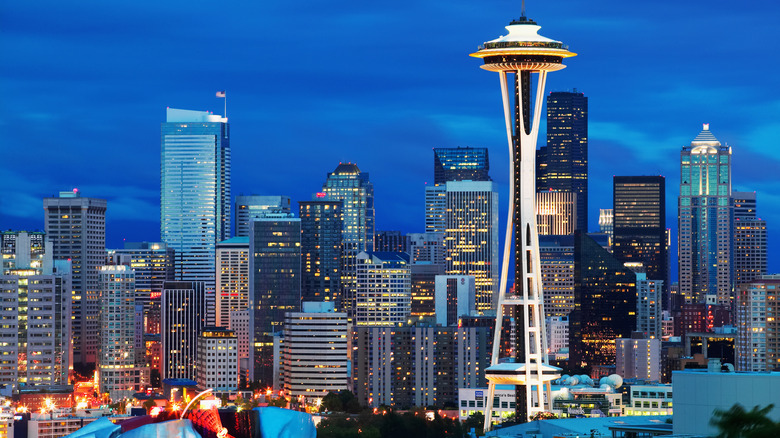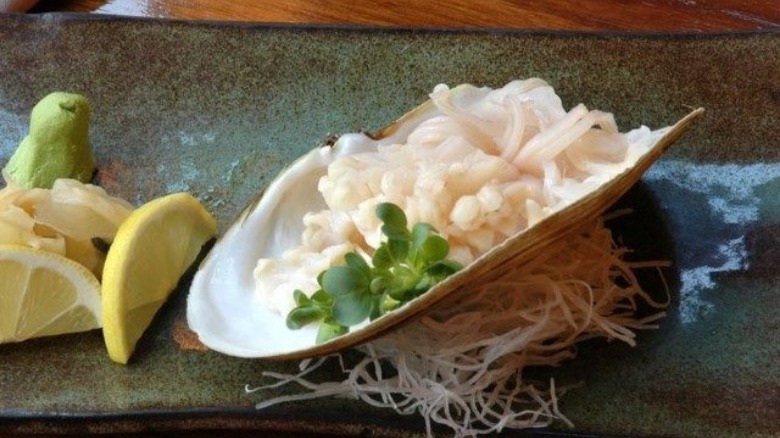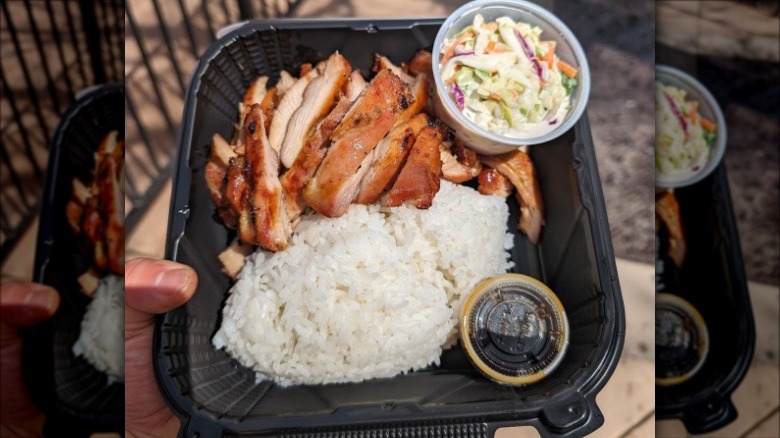What Types Of Restaurants Is The Pacific Northwest Known For?
The first thing that comes to mind when we think of the Pacific Northwest's culinary contributions may well be the Seattle coffee chain that took over the world. Starbucks may now be a universal phenomenon (how long until there's one on the space station?), but the city's coffee culture still thrives in indie shops and local chains such as Caffe Ladro and Caffe Vita. (The latter, however, has taken a page from Starbucks' playbook by opening locations in Arizona and New York.) Portland, Oregon, the region's other hub, is known as a mecca for food truck connoisseurs — needless to say, the West Coast's hipster capital was way into the mobile restaurant scene long before the rest of us knew there were any other options besides the Good Humor van.
A cardamon cortado and a bibimbap burrito are all well and good, but the Pacific Northwest — which, for the sake of brevity, we're defining as the core states of Washington and Oregon — has more to offer in the way of sit-down dining. This includes global goodies ranging from Finnish uunipuuro (oven porridge) at Portland's Broder Café to West African jollof rice from Seattle's Gold Coast Ghal Kitchen. Seattle even has one of the few MLB ballparks to offer fried grasshoppers as a stadium snack. If we had to narrow things down to two must-try regional restaurant types, however, the first would be seafood because the Pacific Ocean is right there. The second would be Asian cuisine, since both Washington and Oregon rank among the states with the highest populations of Asian and Pacific Islanders. In fact, Seattle's just a 10-hour flight from Tokyo.
The Pacific Northwest is a prime spot for locally sourced seafood
If you want salmon and tuna so fresh they're practically swimming, head to Astoria, Oregon. Although this town may be best known as the location for '80s cult film "The Goonies," it's long been home to a thriving fishing industry. One family-owned fishing boat known as South Bay Wild serves up its catch of the day at South Bay Wild Fish House. Further up the coast on Washington's Willapa Bay, Skylar's purchases its oysters straight from the fisherpersons who dredged them up. In addition to oysters, the restaurant has numerous other seafood specialties including a "bait bite" consisting of clam chowder-topped cheese fries. Should you prefer urban dining, Portland's Fishwife offers fresh local specialties such as Puget Sound steelhead and Dungeness crab.
In Seattle, Taylor Shellfish Oyster Bar will allow you to experience the giant geoduck clam, which is one of Seattle's most famous foods despite its relative rarity (possibly due to the fact that most geoducks are sold to markets in China and Japan). Of course, no seafood lover will want to miss a trip to the Pike Place Market to see the far-famed fish flingers doing their thing. After enjoying the show, you can stop by Pike Place Chowder to fill up on soup made from clams, crab, oysters, scallops, or salmon. If you prefer your lunch with a side of history, though, the place to go is Ivar's Acres of Clams on Pier 54 since it's been serving up fish and chips since 1938.
The region also offers cuisine from all over Asia
If you want to eat your way through the Asian continent but you've let your passport lapse, the Pacific Northwest may be your best alternative to travel. In Seattle, Japanese restaurants are pretty ubiquitous and the city sometimes even claims to have invented teriyaki. While this may not be true, Seattle restaurateur Toshihiro Kasahara made the dish so popular back in the '70s that teriyaki shops can now be found all over the area and it's considered a must-try regional specialty. On the opposite end of the economic spectrum, if not the geographical one, is the $185+ per plate omakase restaurant Sushi by Scratch. While Washington and Oregon have no Michelin Guide inspectors, the mini-chain's Montecito outpost earned a star in 2021 and 2022.
The Pacific Northwest also boasts some of the nation's best Chinese restaurants, including Portland's Duck House and Bellevue, Washington's Facing East (which actually specializes in Taiwanese cuisine). For Korean food, Lakewood, Washington is the place to go, since the region's biggest K-Town offers countless restaurants and groceries (yes, of course there's an H Mart). If you're looking for South Asian specialties, Seattle's Annapurna has Indian and Nepalese-style curries alongside Tibetan momo dumplings and noodle soup. The city has no shortage of Filipino restaurants, either — Marcus Samuelsson devoted an entire episode of "No Passport Required" to exploring them, including the speakeasy-themed Knee High Stocking Co where he enjoyed pork adobo and arroz caldo along with the contradictory-sounding Prohibition-era cocktails.


